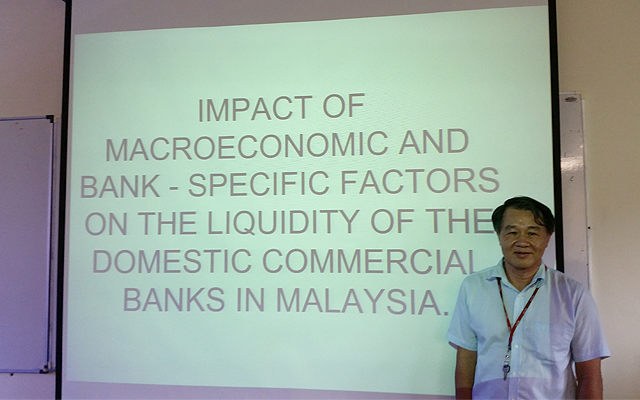

In line with UTAR’s aim towards excellence in teaching and research, the University strongly encourages its staff and researchers to be involved in cutting-edge research with significant socio-economic impact.
With that, the Centre for Accounting, Banking and Finance (CABF) parked under the Faculty of Business and Finance (FBF) organised a research talk, titled “Impact of Macroeconomic and Bank-Specific Factors on the Liquidity of the Domestic Commercial Banks in Malaysia” at Kampar Campus on 26 July 2017. The talk was delivered by FBF lecturer Tan Kock Lim.
Present at the talk were CABF Chairperson Dr Krishna Moorthy Manicka Nadar and FBF lecturers.

Tan presenting his research paper
During the presentation, Tan said that the main objective of his research is to get a deeper understanding of the impact of macroeconomic and bank-specific factors on the bank’s liquid asset holdings in Malaysia from the period 2006 to 2016 for eight domestic commercial banks, namely Affin Bank, Alliance Bank, AmBank, CIMB Bank, Hong Leong Bank, Maybank, Public Bank and RHB Bank.
He explained, “The theoretical support for this research is provided by the “Financial Accelerator Theory”, “Diamond and Dybvig’s Model”, “Irving Fisher’s Theory of Interest Rate” and “Liquidity Premium Theory”. Among the factors that will be studied in this research are macroeconomic factors including gross domestic products, inter-bank interest rate, government deficit financing and inflation; and bank specific factors including capital adequacy, bank size, non-performing loan, profitability and leverage.”
“The data will be collected from the Government Statistic Report and the BNM Annual Report, World Bank and Bloomberg. In addition to that, Pooled Ordinary Least Square Model, Fixed Effect Model and Random Effect Model of panel regression models would be used to determine the individual-specific effects and time effects,” he added.
Tan enthused, “Once the analysis is completed, the results would assist the central bank to perform its monitoring function, ensure the domestic banks fulfill the requirements to prevent bank panic as well as to maintain the soundness and stability of financial system in Malaysia, provide practical information that will improve the effectiveness of bank managers’ decision making in overcoming the liquidity crisis and determining the bank’s future plan in asset-liability management, evaluate performances indicators to gain more competitive advantage in the industry and serve as a cushion against unexpected crisis.”
The talk ended with an interactive Q&A session and suggestions for further enhancement of this research.
© 2019 UNIVERSITI TUNKU ABDUL RAHMAN DU012(A).
Wholly owned by UTAR Education Foundation Co. No. 578227-M LEGAL STATEMENT TERM OF USAGE PRIVACY NOTICE